Threats to Amphibian Populations of South Florida
Authors
J. Hardin Waddle, Kenneth G. Rice, Frank J. Mazzotti, and H. Franklin Percival
Introduction
Amphibians are widely recognized as useful indicators of ecosystem health (Sheridan and Olson 2003). Aspects of their life history and ecology make them particularly vulnerable to perturbations of natural systems (Collins and Storfer 2003). While many perturbations are natural, e.g. drought, hurricanes, fire, the most harmful disturbances may be directly related to human land use. We have identified three major threats to amphibian species in the protected natural areas of South Florida: introduced species, alteration of the predevelopment hydrologic regime, and recreational off-road vehicle (ORV) use. Current research conducted by the U. S. Geological Survey and University of Florida seeks to understand the effects of each of these threats so that damage from them can be prevented or reversed.
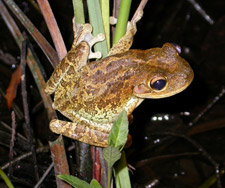
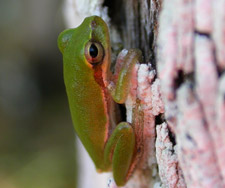
The introduced Cuban treefrog (left) reaches an average size of 45 mm long in Everglades National Park. The squirrel treefrog (right), a native of south Florida, reaches an average size of only 19 mm. The Cuban treefrog may be both a predator and a competitor for resources to the squirrel treefrog.
Introduced Species
Many reptile and amphibian species have been introduced to South Florida and are capable of becoming a major threat to native frog species (Wilson and Porras 1983). For example, the Cuban treefrog (Osteopilus septentrionalis) has become established in natural areas within Everglades National Park (Meshaka 2001). Our research on this species involves a project in which Cuban treefrogs and native treefrog populations were monitored using capture-mark-recapture techniques. After 1 year of monitoring, Cuban treefrogs were removed and the recovery of native frogs was monitored. Results from this study indicate that Cuban treefrogs can cause severe reductions in native treefrog abundance and survival in areas where Cuban treefrog abundance is high. Understanding the potential of Cuban treefrogs to impact native species is an important part of using amphibians as indicators of ecosystem restoration success

(Click for larger image)
This chart shows the capture rate (number of frogs per trap check) at one site in Everglades National Park where abundance of Cuban treefrogs was high. Prior to removal of Cuban treefrogs, capture rates of squirrel treefrogs were extremely low, but after the removal of Cuban treefrogs began the rates increased. Estimates of survival rates for squirrel treefrogs show a similar pattern.

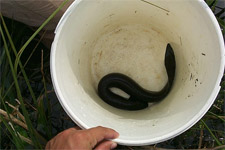
Trapping for greater siren. These large, aquatic salamanders occur in flooded prairie and marsh habitats throughout the greater Everglades ecosystem. Sirens are seldom seen by people because they spend all of their time in heavily vegetated water, or buried in mud during the dry season. These animals can be very abundant locally. We are using radio telemetry to study the movements of these secretive animals.
Alteration of the Predvelopment Hydrologic Regime
Alteration of predevelopment hydrologic patterns has been widespread throughout the natural areas of South Florida. We are conducting several lines of research into amphibian ecology in relation to hydrology. The goal of this research program is to better understand how amphibian populations and individuals respond to short term hydrologic changes in order to better predict how they may respond to hydrologic restoration in South Florida. We have begun a radiotelemetry project on the greater siren (Siren lacertina) to determine how its movement patterns change as water levels rise and recede in the short-hydroperiod marshes used by this species. We are also using capture-mark-recapture techniques to examine the movement patterns of treefrogs, especially the transition between habitats, in relation to hydrology.
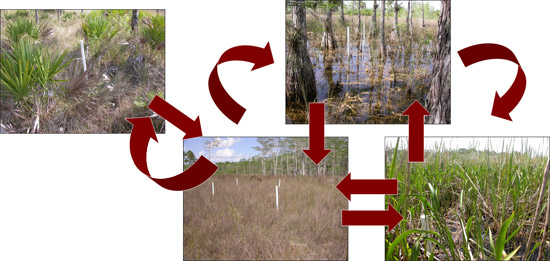
Four habitat types (clockwise starting far left): Pineland, Cypress Strand, Marsh, Prairie.
Using capture-mark-recapture to model the effect of hydrology on the movement of green treefrogs. PVC pipe arrays are set up in pineland, cypress, prairie, and marsh habitat. The transition probability of an individual frog as a function of hydrology at the starting and ending habitat is estimated. This model will be used to make predictions about how populations of frogs will change as hydrological restoration of the greater Everglades ecosystem is conducted.
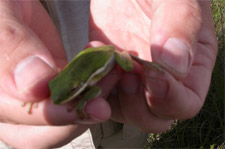
A green treefrog captured in a PVC pipe refuge.
Off-Road Vehicle Use
The use of off-road vehicles is a major management concern in Big Cypress National Preserve (Duever et al. 1981), but almost no research has been conducted to date on the impacts ORVs may have on vertebrate wildlife. We have completed a landscape-scale analysis of anuran distribution within Big Cypress in relation to an index of ORV use. We used the PAO method developed by (MacKenzie et al. 2002) to model the probability of site occupancy given a variable index of ORV use. The results indicate that some species appear to be strongly negatively associated with ORV use, some are strongly positively associated, and many do not appear to be affected by ORV use.
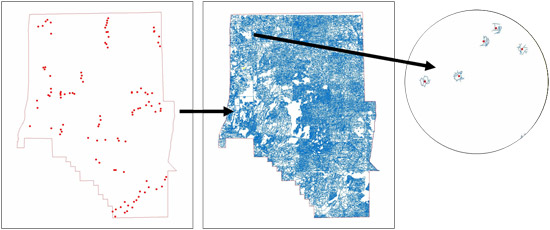
The index of ORV use was created using GIS data of all the linear disturbances in Big Cypress. This file was clipped in 500 m circles around points where amphibians were sampled. The total length of trail was summed within each circle. Each sum was subtracted from the mean to create the index in units ranging from -3 to 7.
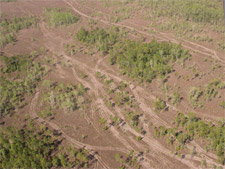 |
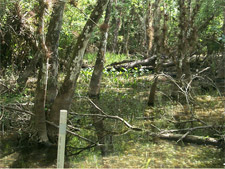 |
| Aerial view of ORV trails in a marl prairie habitat with scattered pine and cypress trees. This type of view is typical of much of the preserve. | One of the more than 100 sites sampled in Big Cypress during this study. This is an example of a long hydroperiod site. |
Literature Cited
Collins, J. P., and A. Storfer. 2003. Global amphibian declines: sorting the hypotheses. Diversity and Distributions 9:89-98.
Duever, M. J., J. E. Carlson, and L. A. Riopelle. 1981. Off-road vehicles and their impacts in the Big Cypress National Preserve. National Audubon Society, Ecosystem Research Unit.
MacKenzie, D. I., J. D. Nichols, G. B. Lachman, S. Droege, J. A. Royle, and C. A. Langtimm. 2002. Estimating site occupancy rates when detection probabilities are less than one. Ecology 83:2248-2256.
Meshaka, W. E. 2001. The Cuban treefrog in Florida. University of Florida Press, Gainesville, FL.
Sheridan, C. D., and D. H. Olson. 2003. Amphibian assemblages in zero-order basins in the Oregon Coast Range. Canadian Journal of Forest Research 33:1452-1477.
Wilson, L. D., and L. Porras. 1983. The ecological impact of man on the south Florida herpetofauna. University of Kansas Museum of Natural History Special Publication 9:89.
Citation
Waddle, J.H., Kenneth G. Rice, Frank J. Mazzotti, and H. Franklin Percival. (2004, December). Threats to Amphibian Populations of South Florida. Poster presented at the National Conference on Ecosystem Restoration, Orlando, Florida.




